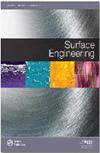喷砂清理钢基体的测量方法和分形维数
IF 2.6
4区 材料科学
Q3 MATERIALS SCIENCE, COATINGS & FILMS
引用次数: 1
摘要
摘要钢基体的形态参数决定了涂层和粘合剂的附着力。采用三种不同的评估方法(横截面图像、接触式触笔仪器和条纹光投影)对喷砂清洁的基材进行了评估。使用不同的磨料,共生成了12种表面构型。分形维数采用盒计数法估计。采用实验设计和方差分析进行统计分析。影响因素包括磨料类型、表面处理等级、表面粗糙度和表面轮廓测量方法。三种测量方法的分形维数的相对趋势相似。分形维数的归一化值约为接触式触笔和条纹光投影的两倍。由触针测量得到的分形值具有最高的可重复性,而由截面图像得到的分形值具有最低的可重复性。关键词:横截面分形维数轮廓冲击条纹线投影触笔仪器披露声明作者未报告潜在利益冲突。本研究得到了德国柏林联邦经济事务和能源部(BMWi)的财政支持,通过FoKO-Wind项目[资助号:03EE2006A]作为2007年德国气候变化研究项目的一部分。Energieforschungsprogramm”。本文章由计算机程序翻译,如有差异,请以英文原文为准。
Measurement methods and fractal dimensions of blast-cleaned steel substrates
ABSTRACTMorphological parameters of steel substrates determine the adhesion of coatings and adhesives. Three different assessment methods (cross section image, contact stylus instrument, and stripe light projection) were applied to blast-cleaned substrates. A total of 12 surface configurations were generated with different abrasive materials. The fractal dimensions were estimated by means of the box-counting method. Design of experiment and ANOVA were applied to statistically analyze the relationships. Factors included abrasive type, surface preparation grade, surface roughness, and surface profile measurement method. Similar relative trends for the fractal dimensions resulted for the three measurement methods. The normalized values of the fractal dimensions were approximately twice as high for the cross section profiles compared to the ones from contact stylus and stripe light projection. Fractal values derived from contact stylus measurements showed the highest repeatability, whereas those derived from cross section images showed the lowest repeatability.KEYWORDS: Cross sectionfractal dimensionprofile impactstripe line projectionstylus instrument Disclosure statementNo potential conflict of interest was reported by the author(s).Additional informationFundingThis study received financial support from the Federal Ministry of Economic Affairs and Energy (BMWi) in Berlin, Germany, through the ‘FoKO-Wind’ project [grant number: 03EE2006A] as part of the ‘7. Energieforschungsprogramm’.
求助全文
通过发布文献求助,成功后即可免费获取论文全文。
去求助
来源期刊

Surface Engineering
工程技术-材料科学:膜
CiteScore
5.60
自引率
14.30%
发文量
51
审稿时长
2.3 months
期刊介绍:
Surface Engineering provides a forum for the publication of refereed material on both the theory and practice of this important enabling technology, embracing science, technology and engineering. Coverage includes design, surface modification technologies and process control, and the characterisation and properties of the final system or component, including quality control and non-destructive examination.
 求助内容:
求助内容: 应助结果提醒方式:
应助结果提醒方式:


